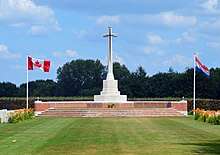Groesbeek Canadian War Cemetery
Groesbeek Canadian War Cemetery and Memorial (French:Le Cimetière de Guerre Canadien Groesbeek) is a Second World War Commonwealth War Graves Commission military war grave cemetery, located in the village of Groesbeek, 8 km (5.0 mi) southeast of Nijmegen in the Netherlands. Of the total 2,619 burials, the cemetery contains 2,338 Canadian soldiers. It was built to a design by Commission architect Philip Hepworth.
| Groesbeek Canadian War Cemetery | |
|---|---|
| Commonwealth War Graves Commission | |
 Cross of Sacrifice | |
| For soldiers who were killed during World War II | |
| Established | February 1945 |
| Unveiled | 4 November 1946 |
| Location | 51°47′52″N 05°55′51″E near |
| Total burials | 2,619 |
Unknowns | 20 |
| Burials by nation | |
Allied Forces
| |
| Burials by war | |
World War II: 2,617 | |
| Statistics source: Cemetery details. Commonwealth War Graves Commission. | |
History
The cemetery is unique in that many of the dead were brought here from nearby Germany. It is one of the few cases where bodies were moved across international frontiers. It is believed that all fallen Canadian soldiers of the Rhineland battles, who were buried in German battlefields, were re-interred here (except for one who is buried in Reichswald Forest War Cemetery).[1] General Crerar, who commanded Canadian land forces in Europe, ordered that Canadian dead were not to be buried in German soil.
The cemetery also has a Cross of Sacrifice within it.[2]
Thousands of Dutch children tend the graves of the soldiers buried here as they do throughout the Netherlands.
Commemoration
Within the cemetery stands the Groesbeek Memorial, which commemorates members of the Commonwealth land forces who died during the campaign in north-west Europe between the time of crossing the Seine River at the end of August 1944 and the end of the war in Europe. There are 1,016 names on the memorial; although since the date of completion of the name-panels, graves have been found for four men commemorated by it. The Bayeux Memorial in Normandy, France honours 103 Canadian servicemen and women.[3]
The memorial consists of twin colonnaded buildings which face each other across the grass forecourt of the cemetery, between the entrance and the "Stone of Remembrance." The names of the men whose graves are unknown are inscribed in panels of Portland stone built into the rear walls.
International Four Days Marches Nijmegen
On the third day of the International Four Days Marches Nijmegen, the route leads along the Canadian military cemetery, and the military participants commemorate their colleagues from the Second World War during an impressive ceremonial gathering.
Notable graves
- Aubrey Cosens (1921–1944) of the Queen's Own Rifles of Canada VC[4]
- John Baskeyfield (1922–1944) of the South Staffordshire Regiment VC[5] is remembered on the memorial.
- Gustave Biéler, Frank Pickersgill and Roméo Sabourin, Canadian members of the Special Operations Executive who were sent undercover into occupied France; all three were caught by the Germans and sent to concentration camps, where they were executed. They are remembered on the memorial
- Terrence Hicks GM (1920-1944) of the 1st Parachute Squadron, Corps of Royal Engineers is remembered on the memorial (Hicks was killed in action on 19 September 1944, aged 24, in the Marktstraat area of Arnhem and has no known grave). Awarded the GM for an act of conspicuous gallantry in Gibraltar in 1942.[6]
Images
 Memorial
Memorial Field of Honor
Field of Honor Memorial, inside
Memorial, inside
Nearby Commonwealth War Graves
References
- see Commonwealth War Graves Commission
- "'File:Cross of Sacrifice.jpg'". wikimedia.org. Retrieved 18 March 2013.
- Canadian Encyclopedia: Monuments, World Wars I and II Archived 2011-08-10 at the Wayback Machine
- Canadian Virtual War Memorial
- Commonwealth War Graves Commission
- WO 373/67 Pt.2 and London Gazette dated 10 July 1942
External links
| Wikimedia Commons has media related to Groesbeek Canadian War Cemetery. |
- Cemetery details. Commonwealth War Graves Commission.
- Government of Canada website for the Groesbeek Memorial
- Groesbeek Canadian War Cemetery at Find a Grave
- British Pathe news clip of the dedication ceremony, held on 5 May 1947 at the cemetery's Cross of Sacrifice with Queen Wilhelmina of the Netherlands